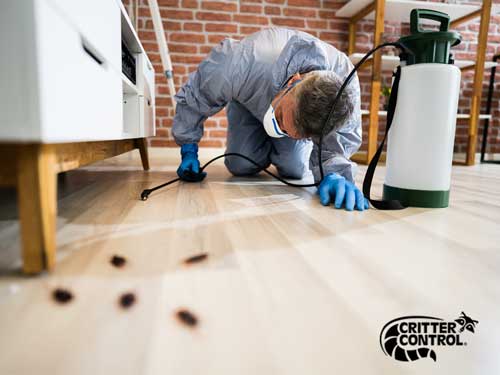Trusted A1 Exterminator Charlotte NC - Comprehensive Pest Solutions
Trusted A1 Exterminator Charlotte NC - Comprehensive Pest Solutions
Blog Article
Bed Insect Treatment Failure: Contrasting Chemical Vs. Non-Chemical Solutions
In the world of bug control, particularly when managing the relentless concern of bed pests, the option in between chemical and non-chemical therapy options can be a crucial one. Both methods offer distinct advantages and disadvantages, influencing variables such as performance, safety and security factors to consider, and overall cost. By analyzing the nuanced details of each approach, a more clear understanding of which path to go after in dealing with a bed bug problem can be attained.
Efficiency of Chemical Therapies
Chemical therapies for bed insect invasions have been extensively acknowledged for their potent and rapid efficiency in eliminating these parasites. When thinking about the effectiveness of chemical treatments, it is crucial to recognize that they can supply a detailed and fast option to a bed insect trouble. Specialist pest control specialists often rely upon insecticides to target bed bugs at different stages of their life process, consisting of grownups, fairies, and eggs. These chemicals generally work by disrupting the bed pests' nerves, bring about paralysis and ultimate death.
Furthermore, chemical treatments have the benefit of using recurring impacts, indicating that they can remain to get rid of bed pests even after the preliminary application. This residual action is especially valuable in combating any type of potential re-infestations. Furthermore, the quick activity of chemical treatments can bring alleviation to people facing extreme bed insect problems, permitting them to restore control of their space quickly.
Safety Concerns With Chemical Solutions
One vital element that needs cautious factor to consider when using chemical services for bed bug treatment is making certain the security of occupants and the environment. Direct exposure to specific chemicals used in bed insect treatments can lead to breathing concerns, skin irritability, or other negative reactions, particularly in individuals with pre-existing problems or sensitivities.
Additionally, the environmental effect of chemical options is one more significant consideration. Some pesticides used in bed pest therapies may be harmful to beneficial pests, wild animals, and ecosystems if they leach into the soil or water supply. It is important to utilize chemical therapies carefully, complying with security guidelines, and considering less poisonous alternatives to minimize these threats and make certain the risk-free and reliable administration of bed insect infestations.
Benefits of Non-Chemical Methods
Taking into consideration the prospective security concerns and ecological effect related to chemical options for bed bug therapy, discovering non-chemical strategies provides an appealing alternative with a number of unique advantages. Non-chemical approaches provide a much safer option for houses, especially those with people, pets, or kids sensitive to extreme chemicals. These strategies remove the threats of direct exposure to toxic compounds, lowering the potential for negative wellness results. Furthermore, non-chemical therapies are environmentally pleasant, as they do not add to air or water pollution, making them a sustainable choice for pest control.
In addition, non-chemical remedies can be efficient mice removal in targeting bed pests, consisting of hard-to-reach areas where chemical therapies may not permeate. Approaches such as heat therapy, vacuuming, vapor cleansing, and mattress encasements offer comprehensive elimination without making use of unsafe chemicals. Furthermore, non-chemical methods can be much less disruptive, calling for minimal preparation and enabling for quicker reentry right into dealt with areas. Generally, going with non-chemical bed bug treatment methods not only prioritizes safety and security and environmental management however also makes sure efficient and extensive insect control.
Limitations of Non-Chemical Treatments

In addition, non-chemical treatments typically need numerous applications to accomplish successful removal. This can be taxing and might not constantly ensure complete elimination of all bed pests and their eggs, particularly in hard-to-reach or covert locations.
Additionally, the success of non-chemical therapies greatly depends on appropriate implementation and thoroughness, which can be challenging for individuals without specialist proficiency. Inadequate application of non-chemical methods may lead to incomplete obliteration, causing relentless invasions and the need for additional therapies.
Therefore, while non-chemical therapies have their advantages, it is necessary to acknowledge these constraints and consider them when determining the most reliable approach for handling bed bug problems.
Cost Contrast: Chemical Vs. Non-Chemical Options
Provided the limitations linked with non-chemical therapies, a vital facet to evaluate in the context of bed insect monitoring is the expense comparison between chemical and non-chemical options. In comparison, non-chemical therapies like warm treatment or heavy steam can be extra pricey, with costs ranging from $1,000 to $6,000 for a whole home. While the preliminary cost of chemical therapies may seem lower, several therapies may be required to completely eliminate the invasion, potentially raising the general cost.
Conclusion

Thinking about the prospective security problems and environmental influence connected with chemical services for bed insect treatment, discovering non-chemical approaches offers an encouraging alternative with numerous distinct benefits.Provided the constraints linked with non-chemical therapies, a crucial facet to examine in the context of bed bug monitoring is the cost contrast in between chemical and non-chemical options. In contrast, non-chemical therapies like warmth therapy or vapor can be a lot more costly, with costs varying from $1,000 to $6,000 for a whole home. While the first cost of chemical treatments may seem lower, multiple treatments might be called for to totally eradicate the infestation, possibly enhancing the overall price.In conclusion, when contrasting chemical and non-chemical bed bug treatment choices, it is vital to consider effectiveness, safety and security, benefits, limitations, and price.
Report this page